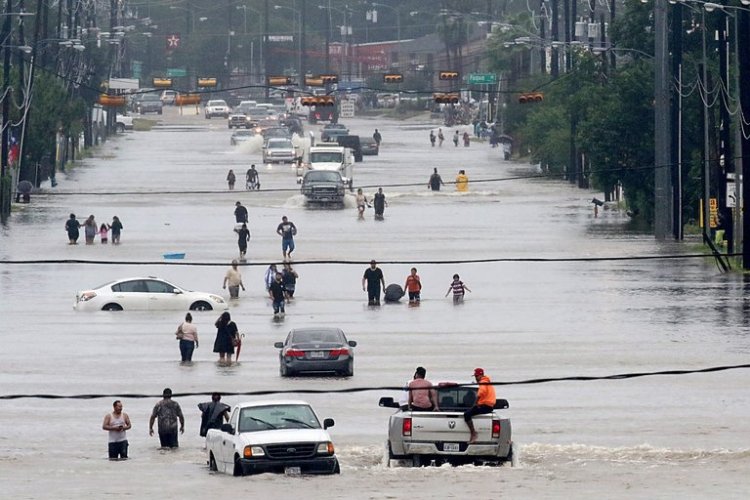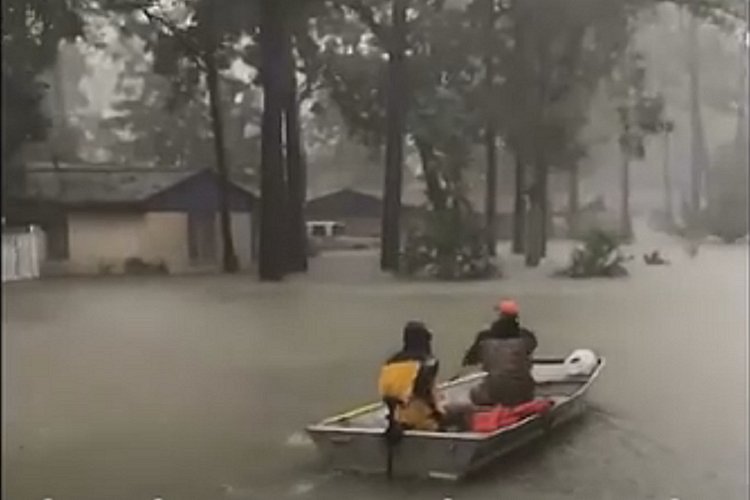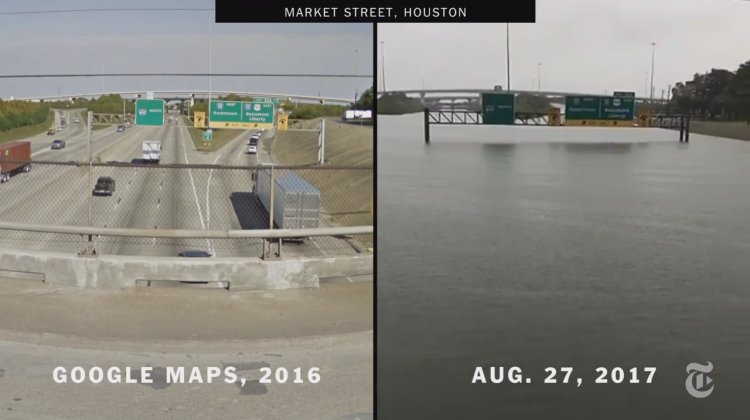 People waded through floodwaters in Houston on Sunday. Credit Thomas B. Shea/Agence France-Presse — Getty Images |
 People waded through floodwaters in Houston on Sunday. Credit Thomas B. Shea/Agence France-Presse — Getty Images |
Overwhelmed by the news from Texas since Hurricane Harvey made landfall? Here is an overview of coverage by The New York Times that will be updated as events continue.
At least 10 people have been killed and many more injured. Houston, the fourth-largest city in the United States, has been inundated: Parts of Harris County have received more than 30 inches of rain, according to the National Weather Service, and that will only increase. The rain is expected to continue through Wednesday.
Unlike many other cities in the hurricane's path, Houston did not order evacuations before the storm, and countless residents were trapped in flooding homes. People fled to higher floors, and then to roofs; the Coast Guard rescued dozens. Chief Art Acevedo of the Houston Police Department warned residents on Sunday not to take shelter in their attics "unless you have an ax or means to break through onto your roof."
Gov. Greg Abbott of Texas, calling the storm "one of the largest disasters America has ever faced," said the region would not recover anytime soon.
 Texans with boats are patrolling neighborhoods around Houston and bringing residents stranded by flooding to safety. By BARBARA MARCOLINI on Publish Date August 28, 2017. Photo by Tamir Kalifa for The New York Times. |
Emergency dispatchers were overwhelmed, and some residents began pleading for help on social media. Many people shared an image of nursing home residents sitting in waist-high waters before they were rescued. Clifford Krauss, a Times reporter who lives in Houston, filed a dispatch from his own flooded home.
Homeless Houstonians endured a night of terror as Harvey pounded the city from Saturday into Sunday. All across the state, dramatic rescues unfolded. Many people went to great lengths to take their pets with them to safety.
In parts of Texas where the worst had passed, residents tried to assess the damage.
Houston's health care infrastructure struggled to treat victims. The brutal storm is also putting the brakes on the area's recent economic upswing.
What set Harvey apart was its rain. The downpour has been torrential and unceasing. Once the storm made landfall, it essentially stalled. Roads in Houston and elsewhere were turned into raging rivers. By the time the storm ends, some areas may see more than 50 inches of rain, forecasters said.
Scientists say the hurricane was fueled by a deadly combination of factors, including warm water in the Gulf of Mexico and a lack of wind in the upper atmosphere, which might otherwise have guided the storm away from land.
"This event is unprecedented & all impacts are unknown & beyond anything experienced," the National Weather Service tweeted Sunday morning.
Harvey has been called a "500-year flood," but that term may be misleading.
 Houston before and after Harvey shows devastating flooding, with water concealing some of the surrounding area and deluging highways. By MALACHY BROWNE and AINARA TIEFENTHÄLER on Publish Date August 27, 2017. |
For many people, the images of inundated streets and victims plucked from rooftops evoked Hurricane Katrina.
Tropical Storm Harvey strengthened into a hurricane over the Gulf of Mexico last week and made landfall northeast of Corpus Christi, Tex., around 9:45 p.m. on Friday. It was a Category 4 hurricane with winds of 130 miles per hour. It then moved offshore before making landfall again on the shore of Copano Bay, this time as a Category 3 hurricane.
The affected area includes some of Texas' most populous cities, stretching along the state's Gulf Coast from Corpus Christi to Houston, and inland to Austin and San Antonio. Parts of Louisiana are also expecting heavy rain.
President Trump responded to the storm with a series of tweets, noting the severity of the disaster and praising emergency workers. He signed a federal disaster proclamation and made plans to visit Texas on Tuesday.
In a news conference with the president of Finland on Monday afternoon, Mr. Trump said he had just spoken with Governor Abbott. He said he expected to receive formal requests for federal aid "very soon," and predicted that Congress would approve them "very, very quickly."
Houston opened its convention center as a mass shelter, and Dallas planned to do the same. Tens of thousands of people spent the weekend in shelters. In San Antonio, some of them talked to a Times reporter about their fears for what awaited them back home.
Many organizations are helping victims on the ground. Here are a few of them; a more complete list can be found here.
• The Hurricane Harvey Relief Fund was established by Mayor Sylvester Turner of Houston and is administered by the Greater Houston Community Foundation.
• The Houston Food Bank, the Galveston County Food Bank and the Food Bank of Corpus Christi are accepting online donations.
• The Houston Humane Society and the San Antonio Humane Society are helping animals affected by the storm.
• United Way of Greater Houston has established a flood relief fund.
• Save the Children is accepting donations.
• GoFundMe is listing all storm-related funding campaigns on one page. (The Times has not vetted any individual campaigns.)
Some scams have begun circulating online. Here are a few things to watch out for.